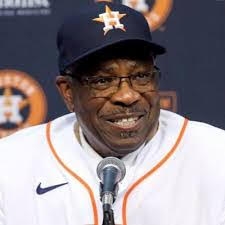The World Series ought to wrap up this week—and here’s hoping Dusty Baker brings home the prize as a reward for his long career of facing triumph and challenges with equal measures of perseverance, integrity and skill.
There’s much about Baker that defies tidy quantification. That’s a rich irony because there’s nothing quite like baseball for breaking down a game with attempts to quantify the value of performance through statistics.

Is there anything that’s at once so elegantly efficient and depressingly bloodless as a box score? The standard box score won’t take much more than a few square inches on paper, and its rows and columns of data can be understood by the initiated at a glance. That efficient bit of space gives a basic account of the game—the result, logs on individual performances, a record of how the contest unfolded over time, location, size of crowd, who was in charge, etc.—all without a hint of flesh and bone or muscle or heart.
The stats are simple inventories that offer grist for computations of basics. A “run batted in”—or RBI—is a tally of any instance when one player’s actions at bat cause or allow another player to score a run by crossing home plate. A player whose hit—or walk, or sacrifice, or other result—causes a teammate to score is said to have batted the run in. The hitting championships in baseball are based on a similarly simple equation. Trophies go to the player in each league with the highest average—a mark that is figured by dividing the number of hits by the number of times at bat (not every plate appearance is an “at bat,” but let’s not veer into the weeds at this point).
There are other longstanding measures such as earned-run-average, or ERA, slugging percentage and fielding percentage. Some other stats have been devised in more recent years in a bid for more analytical texture. WHIP is a measure of the combined number of walks and hits a pitcher surrenders on average per inning. Walks, Hits, per Inning Pitched. Simple math.
Now University of California-Irvine Professor of Economics Michael McBride is trying to introduce a couple of newer statistics that would aim to capture some of the teamwork of baseball.

Here’s a quick example of what McBride is up to: A player gets a one-base hit, generally called a single, and advances to second base on a teammate’s sacrifice bunt. The bunt is a tactic intended to advance the first player to second base at the cost of the second batter being out at first base—and I wouldn’t blame you if you had to read that again. Then comes the next player, who gets a single, which often would allow the teammate on second base to cross home plate.
The current view of this would credit the first player, who hit the single and came around to cross the plate, with a run scored.
The third player, who hit the single that scored the first teammate—as in, batted the runner in—would get an RBI.
McBride’s system—called the Shapley Method in reference to a prior mathematical value conceived by the late UCLA economist and Nobel Prize winner Lloyd Shapley—would also provide some statistical credit to the player whose sacrifice bunt put the initial hitter in position to score from second base. The player would not have scored from first base on a single, so the bunt that moved him to second base was crucial.
Current baseball statistics make no provision to share any credit with the player who executed the sacrifice bunt.
That’s just one of the circumstances McBride aims to address for baseball, a sport he played as a youth at Venice High School in LA and has coached for his children.
The last time I spoke with McBride, his statistical proposals—called Shapely Run Credits and Offensive Shapely Win Credits—were under consideration for publication in an academic journal.
Whoever takes up the subject of McBride’s proposed statistical categories will have to face some critics who think that a recent trend toward “data analytics” takes the guts and instinct—indeed, some of the joy—out of baseball.
I take a different view as the only journalist in Los Angeles who has properly covered the obvious corruption of homelessness programs over the past three years.
I know I just made a sharp turn, but this is going somewhere.
A key to my being able to recognize clues to corruption is my keen sense of numeracy. I’m very good at doing basic math and figuring percentages and other aspects at a glance—and it occurs to me to do so whenever I encounter numbers in a story.
My sense of numeracy is how I came to a cold-eyed realization that the City of Los Angeles paid twice as much as it should have for space for a homeless shelter on Paloma Street, as you can see here. It’s also how I found the human tragedy amid the facts that the landlord of the property received more than half a million dollars in rent—and more than 1,000 homeless individuals died—while public officials were mired in corruption that caused more than a year of delays on the project, as you can see here.
How did we get from baseball to this?
Because I learned that sense of numeracy from baseball and its box scores—the ability to look at the numbers behind that homeless shelter on Paloma Street and to know there’s something wrong started when I was poring over box scores to follow the big leaguers and trying to keep track of my own performance in Little League.
That covered the numbers.
Baseball legends such Dusty Baker—who all fail more than they succeed because that’s how the game goes—helped teach me about the human elements that give statistics meaning.
Nathanson’s Norwegian Prospects

Congratulations to Mapleton Investments boss Marc Nathanson on his nomination to the post of ambassador to Norway by President Joe Biden.
It’s a top-tier foreign service post for a non-career diplomat—Oslo is a lovely city in a stable country with geopolitical significance.
It’s notable that Nathanson only recently finished a term as chair of the Downtown LA-based Pacific Council on International Policy and looks set to become the organization’s latest member to serve as an ambassador.
Making an Impact with Michelson Philanthropies
Check below to listen to the latest episode in a podcast series produced for Michelson Philanthropies, a multi-faceted organization overseen by Dr. Gary Michelson, a surgeon-turned-medical device inventor, and his wife, Alya, a journalist by training. Michelson Philanthropies provides an organizational umbrella over various initiatives and programs intended to “make life a little less unfair.”

This episode features a talk with Alya about Michelson Philanthropies’ FirstGen Initiative—what it aims to accomplish, why it’s vitally important to immigrant women of diverse backgrounds and experiences, and how her own experiences add to her perspective on such programs.
There’s plenty more to consider, too, as you’ll hear in this episode of “Making an Impact with Michelson Philanthropies.”
Stop This Thing
Back to sports for a critique of modern media aimed at Jorge Sedano and his fellow ESPN710 AM drive-time yakkers—and just about everywhere else in today’s media, to be fair—for regularly perpetrating a scourge of popular culture found in the phrase “It’s a thing.”
The phrase is often used to describe a trend, practice or development—as in, “Have you heard about dipping donuts in beer? It’s a thing.”
The problem is that “It’s a thing” is bereft of intellectual integrity.
It doesn’t say the thing is popular, which would require some knowledge. Or that it’s healthy or unhealthy, which would require some certainty. Or that it’s good or bad in any way, which would require some reasoning.
“It’s a thing” is a phrase that excuses people who use it from any thought. It’s a placeholder to be used until someone who is smarter or more of a loudmouth comes along to make some more specific claim—true or otherwise—of what the nature or purpose or value of the thing might be.
That’s a 50/50 shot—you might hear it from someone who is actually informed and well intentioned or you might get a blast of hot air from some uninformed blowhard.
It’s a pity that “It’s a thing” is so routinely accepted as some form of intelligence, because the vast majority of us would have much better odds of getting it right if we simply made the effort to think for ourselves.
I guess it is what it is—and don’t get me started on that one.
This Is Some Sort of Record
Back to the sense of numeracy that’s obviously lacking among so many journalists, as exemplified by this from the LA Times’ “Essential California,” a digitally distributed newsletter, on October 25:
“In May, ahead of Memorial Day weekend, Los Angeles International Airport broke a 2021 record for passenger traffic. However, Visit California said in a Sept. 2021 report that both lodging demand and airline travel remain below 2019 levels.”
Traffic at LAX hit a high mark for the year in May, during the first holiday weekend after distribution of a Covid vaccine began in earnest in Southern California, and the local visitor’s bureau said business at hotels and airlines remained below pre-pandemic levels as a variant caused a rise in cases in September.
That’s neither news nor analysis—and distributing it digitally doesn’t magically make it so.
Sullivan Says
It bears explicit mention that taking note of corruption among self-described “progressive” politicians does not make anyone a “conservative” or “right-winger” or anything else other than someone who doesn’t like getting their pocket picked while watching fellow human beings die on our streets as part of the price.







